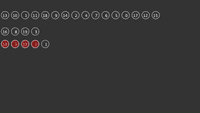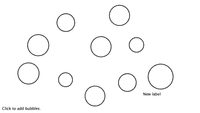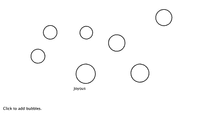Examples+
ArrayList of objects
by Daniel Shiffman
This example demonstrates how to use a Java ArrayList to store a variable number of objects. Items can be added and removed from the ArrayList. Click the mouse to add bouncing balls.
/**
* ArrayList of objects
* by Daniel Shiffman.
*
* This example demonstrates how to use a Java ArrayList to store
* a variable number of objects. Items can be added and removed
* from the ArrayList.
*
* Click the mouse to add bouncing balls.
*/
ArrayList<Ball> balls;
int ballWidth = 48;
void setup() {
size(640, 360);
noStroke();
// Create an empty ArrayList (will store Ball objects)
balls = new ArrayList<Ball>();
// Start by adding one element
balls.add(new Ball(width/2, 0, ballWidth));
}
void draw() {
background(255);
// With an array, we say balls.length, with an ArrayList, we say balls.size()
// The length of an ArrayList is dynamic
// Notice how we are looping through the ArrayList backwards
// This is because we are deleting elements from the list
for (int i = balls.size()-1; i >= 0; i--) {
// An ArrayList doesn't know what it is storing so we have to cast the object coming out
Ball ball = balls.get(i);
ball.move();
ball.display();
if (ball.finished()) {
// Items can be deleted with remove()
balls.remove(i);
}
}
}
void mousePressed() {
// A new ball object is added to the ArrayList (by default to the end)
balls.add(new Ball(mouseX, mouseY, ballWidth));
}
// Simple bouncing ball class
class Ball {
float x;
float y;
float speed;
float gravity;
float w;
float life = 255;
Ball(float tempX, float tempY, float tempW) {
x = tempX;
y = tempY;
w = tempW;
speed = 0;
gravity = 0.1;
}
void move() {
// Add gravity to speed
speed = speed + gravity;
// Add speed to y location
y = y + speed;
// If square reaches the bottom
// Reverse speed
if (y > height) {
// Dampening
speed = speed * -0.8;
y = height;
}
}
boolean finished() {
// Balls fade out
life--;
if (life < 0) {
return true;
} else {
return false;
}
}
void display() {
// Display the circle
fill(0,life);
//stroke(0,life);
ellipse(x,y,w,w);
}
}
Related Examples
This example is for Processing 4+. If you have a previous version, use the examples included with your software. If you see any errors or have suggestions, please let us know.


